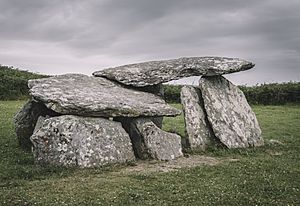Irish megalithic tombs facts for kids
Imagine huge stone structures built a very long time ago! In Ireland, many of these ancient buildings are called 'megalithic monuments.' Most of them are special tombs where people were buried. There are four main kinds: court cairns, passage tombs, portal tombs, and wedge tombs. Archaeologists have found over 1,000 of these amazing stone tombs all over Ireland.
Contents
Types of Ancient Stone Tombs
Court Tombs
Court tombs have an open area at the front, like a courtyard. This courtyard usually faces east, towards the sunrise. From here, you can enter several rectangular rooms, sometimes up to four.
The roofs of these rooms are made with a special technique called 'corbelling.' This is where stones are laid so they stick out a little further than the one below, slowly closing the gap to form a roof. Inside these rooms, archaeologists have found both human bones and ashes from cremated bodies. Around these rooms, there's a low stone wall with tall standing stones called 'orthostats' at the ends. Sometimes, people call them 'lobster-claw cairns' because of their shape.
Passage Tombs
A passage tomb is a very large mound of earth or stones. It has a narrow path or 'passage' that leads from the outside into a central room or several rooms. Some famous examples of passage tombs in Ireland are Newgrange, Knowth, and Dowth. These are truly impressive ancient structures!
Portal Tombs
Portal tombs are often called 'dolmens.' You'll find most of these tombs in the northern part of Ireland. They have a straight-sided room that often gets narrower at the back. The entrance is easy to spot because it has two tall standing stones, called 'portal stones.'
On top of these portal stones sits a huge single capstone. This giant stone rests on the portal stones at the front and slopes down at the back, where it rests on a backstone. Most of the time, the entrance of a portal tomb faces east, towards the sunrise. However, some tombs face different directions. Good examples include Kilmogue in County Kilkenny, Poulnabrone in County Clare, and Knockeen in County Waterford.
Wedge Tombs

You will usually find wedge tombs in the west and northwest of Ireland. They get their name because they look like a wedge! Their roof slopes downwards, and their walls get narrower at one end, giving them their unique wedge shape.
Where are these Tombs Found?
The Irish National Monument Service and the Northern Ireland Sites & Monuments Record keep track of how many tombs there are and where they are located in each of Ireland's four provinces. Here's a quick look at how many of each type of tomb are found in each province:
| Court Tomb | Passage Tomb | Portal Tomb | Wedge Tomb | |
|---|---|---|---|---|
| Leinster | 11 | 83 | 24 | 19 |
| Munster | 7 | 9 | 21 | 337 |
| Connacht | 197 | 90 | 44 | 125 |
| Ulster | 185 | 37 | 96 | 88 |
Many hundreds of other ancient stone tombs and sites have also been found, but they don't fit neatly into these four main types.


